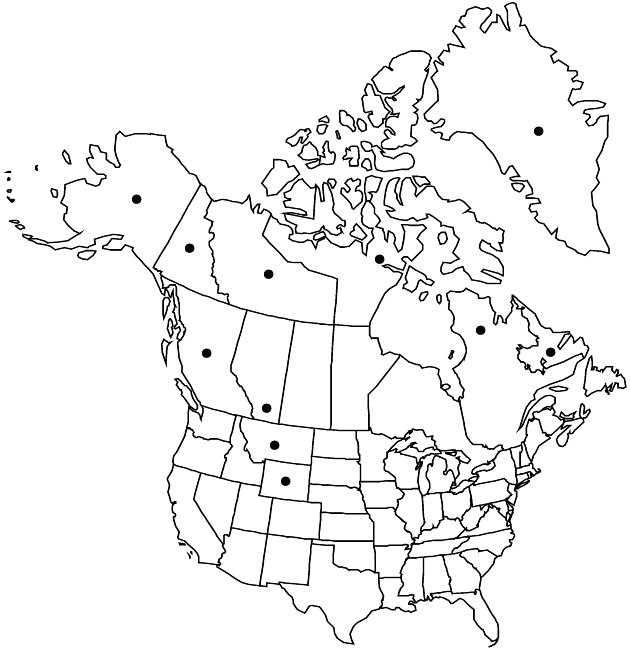familyAsteraceae
genusAntennaria
speciesAntennaria monocephala
subspeciesAntennaria monocephala subsp. angustata
Difference between revisions of "Antennaria monocephala subsp. angustata"
Ark. Bot., n. s. 7: 135. 1968.
Common names: Narrow-leaved pygmy pussytoes antennaire étroite
Basionym: Antennaria angustata Greene Pittonia 3: 284. 1898
Synonyms: Antennaria alpina var. megacephala (Fernald ex Raup) S. L. Welsh Antennaria burwellensis Malte Antennaria congesta Malte Antennaria fernaldiana Polunin Antennaria hudsonica Malte Antennaria megacephala Fernald ex Raup Antennaria pygmaea Fernald Antennaria tansleyi Polunin Antennaria tweedsmuirii Polunin
Treatment appears in FNA Volume 19. Mentioned on page 390, 412.
FNA>Volume Importer |
FNA>Volume Importer |
||
| Line 8: | Line 8: | ||
}} | }} | ||
|common_names=Narrow-leaved pygmy pussytoes; antennaire étroite | |common_names=Narrow-leaved pygmy pussytoes; antennaire étroite | ||
| − | |basionyms={{Treatment/ID/ | + | |basionyms={{Treatment/ID/Basionym |
|name=Antennaria angustata | |name=Antennaria angustata | ||
|authority=Greene | |authority=Greene | ||
| + | |publication_title=Pittonia | ||
| + | |publication_place=3: 284. 1898 | ||
}} | }} | ||
|synonyms={{Treatment/ID/Synonym | |synonyms={{Treatment/ID/Synonym | ||
| Line 54: | Line 56: | ||
|elevation=0–2900 m | |elevation=0–2900 m | ||
|distribution=Greenland;Alta.;B.C.;Nfld. and Labr. (Labr.);N.W.T.;Nunavut;Que.;Yukon;Alaska;Mont.;Wyo. | |distribution=Greenland;Alta.;B.C.;Nfld. and Labr. (Labr.);N.W.T.;Nunavut;Que.;Yukon;Alaska;Mont.;Wyo. | ||
| − | |discussion=<p>Subspecies angustata is apomictic and has a wider geographic range than the amphimictic <i></i>subsp.<i> monocephala</i>. It is easily recognized by heads borne singly, dark phyllaries, and gynoecious population structure.</p> | + | |discussion=<p>Subspecies angustata is apomictic and has a wider geographic range than the amphimictic <i></i></i>subsp.<i><i> monocephala</i>. It is easily recognized by heads borne singly, dark phyllaries, and gynoecious population structure.</p> |
|tables= | |tables= | ||
|references= | |references= | ||
| Line 78: | Line 80: | ||
|publication year=1968 | |publication year=1968 | ||
|special status= | |special status= | ||
| − | |source xml=https://jpend@bitbucket.org/aafc-mbb/fna-data-curation.git/src/ | + | |source xml=https://jpend@bitbucket.org/aafc-mbb/fna-data-curation.git/src/f6b125a955440c0872999024f038d74684f65921/coarse_grained_fna_xml/V19-20-21/V19_672.xml |
|tribe=Asteraceae tribe Gnaphalieae | |tribe=Asteraceae tribe Gnaphalieae | ||
|genus=Antennaria | |genus=Antennaria | ||
Revision as of 19:38, 24 September 2019
Gynoecious (staminate plants unknown). Stems usually stipitate-glandular. Basal leaves spatulate to oblanceolate, faces usually gray-pubescent, adaxial sometimes green-glabrescent. 2n = 56, 60?, 70.
Phenology: Flowering summer.
Habitat: Moist tundra, disturbed margins of solifluction lobes, unstable, gravelly slopes
Elevation: 0–2900 m
Distribution

Greenland, Alta., B.C., Nfld. and Labr. (Labr.), N.W.T., Nunavut, Que., Yukon, Alaska, Mont., Wyo.
Discussion
Subspecies angustata is apomictic and has a wider geographic range than the amphimictic subsp. monocephala. It is easily recognized by heads borne singly, dark phyllaries, and gynoecious population structure.
Selected References
None.
Lower Taxa
None.